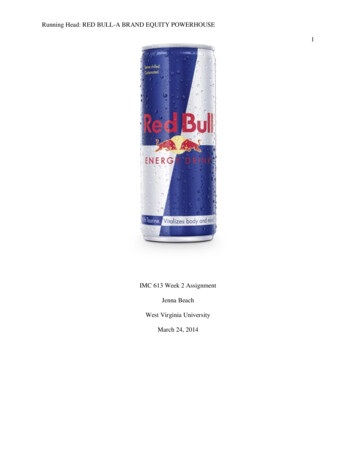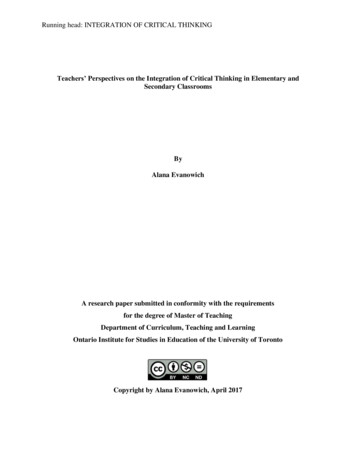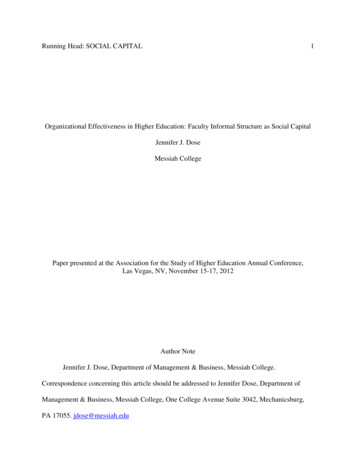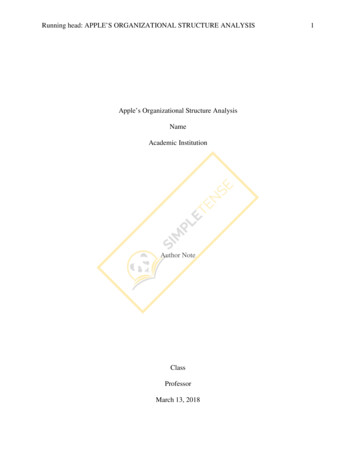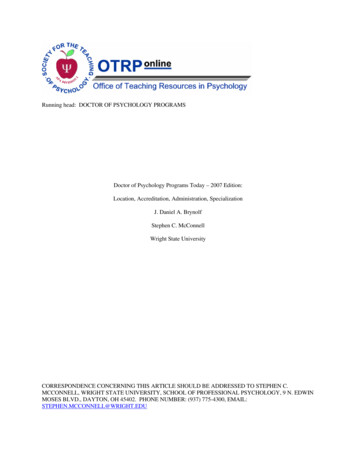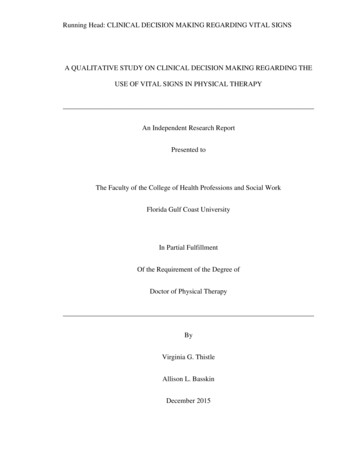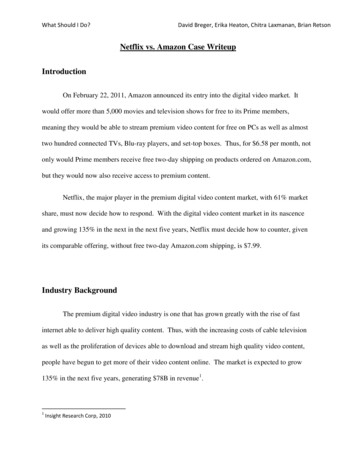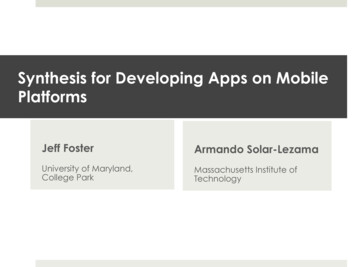
Transcription
Running Head: Netflix Case SynthesisNetflix Case SynthesisJeffrey Donenfeld – J@JeffreyDonenfeld.comUniversity of Denver Daniels College of Business Executive MBA Cohort 67September 17th, 20161
Netflix Case Synthesis2Table of ContentsIssue Identification . 3Foundation for Recomme ndations . 3Closing. 4Works Cited . 5Appendix . 6Appendix - Porter’s Five Forces Analysis (Porter, 2010) . 6Appendix - Paths to Growth. 9Appendix - Four Actions Framework . 11Appendix – Six Path Framework . 12Appendix – Netflix Financial Statements . 16Endnote . 18
Netflix Case Synthesis3Issue IdentificationThe three key decisions Netflix is faced with coming to terms with at this point in their historyare:1. Licensing its proprietary movie and media recommendation engine to 3 rd party providers,while maintaining its existing DVD rental service as one of many service offeringsfeaturing the Netflix recommendation engine. (Shih, Kaufman, & Spinola, 2007)2. Launch its own VOD service, and integrate streaming media capabilities in with theexisting Netflix DVD rental service. This would let consumers use either servicesomewhat interchangeably, and require customer to pay for both, despite their own usage.(Shih, Kaufman, & Spinola, 2007)3. Build a VOD service as a completely separate product. This would allow consumers tochoose which service they use and only pay for that service, but would create asignificant division within the company, and a dilution of their resources. (Shih,Kaufman, & Spinola, 2007)Foundation for RecommendationsCore recommendations for Netflix in this case is primarily: Stay the course of building out VOD product, and enhance future offerings with HDcontent, enhanced metadata, more sophisticated planning and research tools, and accesson mobile, embedded, and other third part devices. Integrate VOD offerings in with existing DVD offerings to preserve existing customerbase. This is based on analysis of the six paths, with a particular emphasis on the productscope, as well as emotional connection.
Netflix Case Synthesis 4Slowly transition to separated service offerings for VOD and DVD, but both under thesame “Netflix” branding. Keep recommendation engine integrated into all Netflix products, focus resources ondeveloping more advanced recommendations. Don’t license out recommendation engineto third parties. Maintain “Blue Ocean” (Mauborgne & Kim, 2005) of separation by continuing toinnovate in media delivery pipeline, deep learning to enhance recommendation engine, aswell as slowly enter into studio industry. This recommendation stems from analysis ofescalating product delivery costs, which will continue to balloon with the existing, “oldschool” DVD delivery product.ClosingIt’s clear that Netflix has been, and will continue to be an innovator in the movie and TVdelivery industry, and is a quick-emerging leader in the recommendation, customersegmentation, and content delivery industries as well. In this critical point in the pathway ofNetflix, they have the opportunity to continue innovating in the areas where they’re alreadystrong – DVD delivery, building VOD, and recommendation engines. However, they also have aripe opportunity for enhancing their vertical integration, and stepping into new industries –namely studio development, media delivery, deep learning, and psychographic segmentation andoptimization.Their current moat is fairly wide, however they face an impending competition fromBlockbuster, and other potential VOD networks. Additionally, they face regulatory and networkcapacity hurdles to overcome before their VOD network can truly flourish unfettered.
Netflix Case Synthesis5Works CitedJenkins, H. W. (2016, April 1). Netflix’s Lesson in Net Neutrality Karma. Retrieved September14, 2016, from The Wall Street Journal: http://www.wsj.com/articles/netflixs- lesson- innet-neutrality-karma-1459550381Kotler, P. (2016). Marketing Management (Vol. 15). Essex, England: Pearson Education Limited.Mauborgne, R., & Kim, C. (2005). Blue Ocean Strategy. Boston: Harvard Business Review.Porter, M. (2010). Porter's Five Forces. (The Internet Center For Management and BusinessAdministration, Inc. ) Retrieved 07 20, 2016, from Quick ih, W., Kaufman, S., & Spinola, D. (2007). Netflix. Boston: Harvard Business SchoolPublishing.
Netflix Case Synthesis6AppendixAppendix - Porter’s Five Forces Analysis (Porter, 2010) Bargaining power of supplierso In this case, suppliers represent a diverse set of technology and media companies.o First, media companies who own the rights to movies and tv content must licensethe content to Netflix. Since content licensing rules are vastly different betweenDVD/physical media and online streaming or downloading, a significant amountof variability could exist as Netflix aims to efficiently license the content itprovides to consumers. Additionally, Netflix faces a significant amount ofuncertainty – the market for online media licensing is just emerging, and it’slikely that many rules may change quickly.
Netflix Case Synthesis7o Additionally, suppliers include technology companies – in the case of Netflix, thisis mainly ISPs, which deliver Netflix VOD Content to consumers. If Netflix is tobe successful, it needs to ensure that its content can be reliably and quicklydelivered over a pipeline that 3rd parties control. Securing this transport willinvolve both technology innovations for Netflix, as well as service level targetsand general support from ISPs. Already today, we’re seeing major issues withISP’s restricting their pipelines, and the ever-growing “net neutrality” debate.(Jenkins, 2016) Threat of substitute products or serviceso Since Netflix is entering into a “virtual” business with its VOD product, itexposes itself to an almost-nonexistent physical barrier to competitors. In thisrespect, it would seem that they’re repositioning themselves squarely into a quickto emerge “Red Ocean” of competitive products. (Mauborgne & Kim, 2005)o However, by integrating their robust recommendation engine, securing top notchand exclusive licensing deals with studios, and being first-to-market with acontinuously innovative and compelling product, there is indeed a chance forNetflix to maintain their Blue Ocean, and genuinely carve out a niche forthemselves in our rapidly changing media and technology environment. Buyers bargaining power of channels and end userso During the period when Netflix was in a DVD rental business, the primarycompetitor was Blockbuster – a video rental chain which required customers totravel to a physical store. While this model is easy to use, convenient, andcompelling for last minute shoppers, it failed to address surge and inventory
Netflix Case Synthesis8constraints, didn’t serve all markets, and was slow to respond to changingsociological nuances.o The Netflix model struck down many of these barriers. However, in itsinnovation, it also created many more potential pitfalls, including opening itselfup to competitors, easier to replicate technology developments, and more vendorsand suppliers in the game, who could exert an increasing bargaining power. Barriers to entryo Barrier to entry are significant for Netflix to break into both the industry ofproviding their recommendation engine to 3rd parties, as well as to create aseparate or integrated VOD market.o Barriers include content licensing, bandwidth allocation, provider partnerships,studio partnerships, IP protection, product maintenance, and achieving a criticalmass of consumers. Rivalry among existing competitorso At this time, the main rivalry comes from competitor Blockbuster. However, witha mature strategy focused on the technological and marketing superiorities ofNetflix’s VOD solution, immediate rivalry can be minimized.
Netflix Case Synthesis9Appendix - Paths to Growth Current Customers, Current Productso In order for Netflix to maintain a consistent growth with its current customers andcurrent products, it’s going to have to massively expand the number and quality ofwarehouses for stocking DVD’s, as well as will have to find a way to edge outcompetitors. The way I see it, the only way this could work would be a massiveincrease in quality of its recommendation engine. However, even if that takesplaces, I can see their “Blue Ocean” creeping out from under them. Current Customers, New Productso Their current customers are poised to become their new customers, with amassive rollout of new products aimed at the next generation of mediaconsumption – online, on demand, all the time. The most logical course of actionfor Netflix in this case may be to continue innovating in new products, continueoffer its original products, and gradually turn its existing customers into newproduct customers, while simultaneously generating products for an entirely newbreed of tech-savvy customers.
Netflix Case Synthesis New Customers, Current Productso No. New customers simply won’t flock to Netflix’s existing line of products inthe numbers that they would need to maintain a viable business. Netflix mustinnovate to stay on top. New Customers, New Productso Clearly, this is the way to go for Netflix – bring both their recommendationengine as well as VOD services to the forefront of their product offering, attractthe new generation of customers, and continue to innovate.10
Netflix Case SynthesisAppendix - Four Actions Framework (Mauborgne & Kim, 2005)The Four Actions Framework helps evaluate key factors used in defining a company’soptimize value curve, ultimately focusing on a goal of a newly defined and efficiently focusedcurve. Raiseo Netflix must raise their VOD delivery technology and recommendation engineintelligence significantly above the industry average. This means allowingcustomers to start watching content faster, in better quality, and at the mostappropriate time. Reduce11
Netflix Case Synthesis12o Reduction of focus on the DVD delivery business may allow competitors to closein, however this industry will be in decline anyway, and it’s not strictly necessaryto continue to sink money and focus into bolstering this fading industry. Createo Netflix should create a more robust content delivery network, and more engagingviewing experience that’s head and shoulders above what anybody else in theindustry is offering. Factors that could contribute to a truly groundbreakingviewing experience include enhanced metadata, viewing recommendations,collaborative viewing, and mobile device viewing. Eliminateo Eventually, Netflix should eliminate their DVD rental business, and get rid ofphysical media entirely. Maintaining warehouse, sorting, and delivery systems iscostly and inefficient, and will not be the way to move into the future.Appendix – Six Path Framework (Mauborgne & Kim, 2005)
Netflix Case Synthesis13Netflix clearly has a number of opportunities to transcend a number of categories of the six pathsframework to plant them squarely in a number of Blue Oceans: Industryo Clearly, Netflix is going after industries that don’t yet fully exist with both theirrecommendation engine as well as their VOD service. On the surface, both ofthese areas seemingly present as somewhat vast “Blue Oceans”. However, uponfurther inspection, it’s obvious that both are easily replicated on a basictechnological level. In order to continue to keep its ocean blue, and preserve its“economic moat”, Netflix must continue innovating in the intelligence of itsrecommendation engine, and ease of delivery of its VOD product, as well ascontinuously expanding its media offering. Another eminently valuable step forNetflix will be to put its media delivery might into building its own productionstudio, thereby sidestepping media licensing issues, controlling its own content,and distributing as it sees fit.o Netflix does have rivals, but by continuing to focus on innovating in newdirections, rather than on beating competition, the blue ocean will remain wideand clear. Strategic Groupo I believe that Netflix’s role within its strategic group is somewhat complicated.This is certainly an area which commands an enhanced level of communication,collaboration, deal making, and strategy in order for Netflix to remain on top.Strategic partners for Netflix will overwhelmingly be internet service providers,networks, and media studios. In the initial phase of Netflix’s drive towards a
Netflix Case Synthesis14successful VOD product, they must strike deals with all of these partners.However, as their business matures, they’ll be able to look across that pool as theybegin to create their own media studios and protected delivery pipelines.o In support of building its recommendation engine, Netflix can immediatelypartner with deep learning and neural network vendors such as AWS and IBMWatson, until it’s at a level where it can move artificial intelligence and deepcomputing in-house for a holistic, value add
17.09.2016 · segmentation, and content delivery industries as well. In this critical point in the pathway of Netflix, they have the opportunity to continue innovating in the areas where they’re already strong – DVD delivery, building VOD, and recommendation engines. However, they also have a ripe opportunity for enhancing their vertical integration, and stepping into new industries – namely studio .

